May 26 - June 1, 2013: Issue 112
Navy League Sea Cadets In Pittwater
IN our March run of Pittwater Gentlemen history pages John Roche featured as the celebrated 'Father of the Pittwater Regattas. Part of the material about this gentleman described a tribute of his dedication to that once famous annual regatta and, as with a lot fo these records, also recorded the younger particpants who so often attended to form Guards of honour or to particpate in the races, the Navy League Sea Cadets, as they were called then:
LOVE OF THE SEAS. TRIBUTE TO YACHTING. GOVERNOR-GENERAL'S SPEECH. The value of yachting from a national standpoint was strikingly emphasised by the Governor-General (Lord Stonehaven) in a speech at the Pittwater Regatta on Saturday. It was the occasion of the presentation by his Excellency of an illuminated address and wallet of notes to the hon. secretary, Mr. John Roche, who had held that position since the Inception of the regatta, 21 years ago.
Mr. C. E. Le Malstre Walker, C.B.E., president of the regatta executive, described the Governor-General as "a good sport." He complimented the officials, especially Mr. Roche, whose service constituted a record. Lord Stonehaven said they thoroughly realised how deserving was Mr. Roche of the praise expressed in the Illuminated Address, "You are very precocious In Australia-which is not to be regretted-and though only 21years of age, it seems to me that this regatta is very flourishing, full of confidence, and sure of success," said his Excellency. "This result must be due very largely to the work of the secretary. (Cheers.) An efficient secretary is a most difficult man to find, and a valuable man to retain when you get him(Renewed cheers.) He is entitled to the gratitude not merely of the racing fraternity, but of the citizens as a whole. Anyone coming from any other port of the world cannot fail to realise the part that yachting plays in the development of Australia. I have been greatly impressed today, from the lads in the dinghies to the elder men whose heads emerged from the cockpit of the flagship. (Laughter.)
Right: 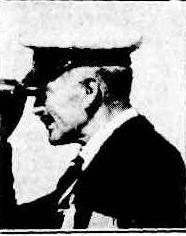 PITTWATER REGATTA. His Excellency the Governor-General (Lord Stonehaven) watching the Pittwater regatta at Broken Bay (N.S.W.).PITTWATER REGATTA. (1928, January 3). The Argus (Melbourne, Vic. : 1848 - 1957), p. 7. Retrieved from http://nla.gov.au/nla.news-article3901320
PITTWATER REGATTA. His Excellency the Governor-General (Lord Stonehaven) watching the Pittwater regatta at Broken Bay (N.S.W.).PITTWATER REGATTA. (1928, January 3). The Argus (Melbourne, Vic. : 1848 - 1957), p. 7. Retrieved from http://nla.gov.au/nla.news-article3901320
"We are fond of yachting," he continued. "Not only Is It a wonderful relaxation, but it is also a splendid sport. Australia is an island, and an island depends on the command of the sea for its development, its happiness, and everything else. Nothing breeds a love of the sea more than yachting. It affords a splendid opportunity of relaxation, assists in the training of character, and contributes towards the future of this great nation."
(Cheers.) His Excellency paid a tribute to the Navy League Sea Cadets, who had provided a guard of honour. Mr. Roche, in reply, said that he had always looked upon his work for the Pittwater Regatta as a hobby. LOVE OF THE SEAS. (1928, January 2). The Sydney Morning Herald (NSW : 1842 - 1954), p. 6. Retrieved from http://nla.gov.au/nla.news-article16431021
The Governor-General (Lord Stonehaven) was received at the Bayview Wharf on Saturday morning by Mr. Roche, who introduced him to the president of the Warringah Shire Council, to Mr. Archdale Parkhill, M.P., Mr C. A. Le Malstre Walker, C.B.E. (president of the regatta committee), Mt. R. W. D. Weaver. M.L.A.. Mr. John Williams, Alderman, S. H. Burns (hon. secretary of Balmain Regatta), Mr. H. G. Alderson (chairman of the New South Wales Rowing Association). Mr. W. N. Cuthbertson (general manager of the Newcastle and Hunter River Steamship Company), and Mrs. E. G. Greig. The Navy League Sea Cadets provided a guard of honour beneath arches of flags and greenery prepared by residents of the district. His Excellency then embarked on the motor cruiser Miramar, belonging to Mr. Stuart F. Doyle, commodore of the Royal Motor Yacht Club. At 3.30. p.m. Lord Stonehaven was received aboard the flag-ship Newcastle. PITTWATER. (1928, January 2). The Sydney Morning Herald(NSW : 1842 - 1954), p. 4. Retrieved from http://nla.gov.au/nla.news-article16431002
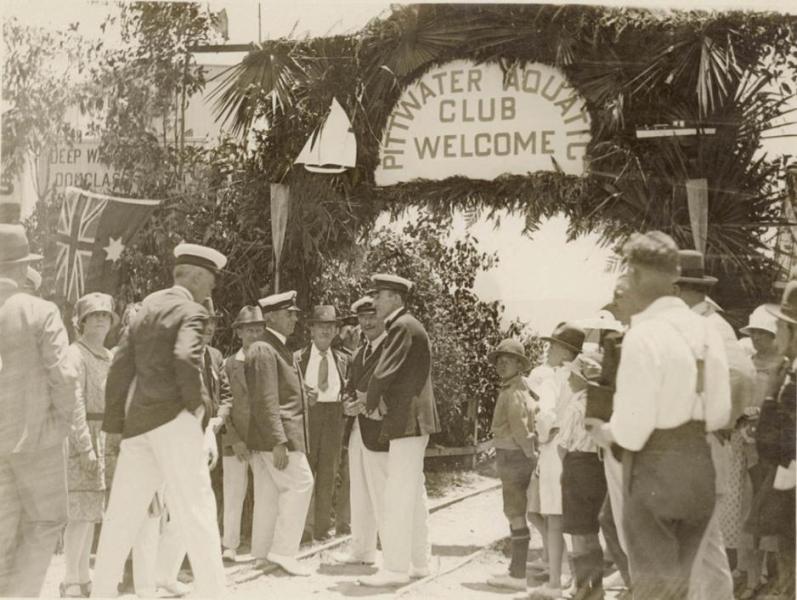
Left: Sam Hood image of Bayview's Pittwater Aquatic Club contributing to the regatta, with John Roche on Bayview Wharf waiting for Lord Stonehaven. Digital Order No. a409025, courtesy State Library of NSW.
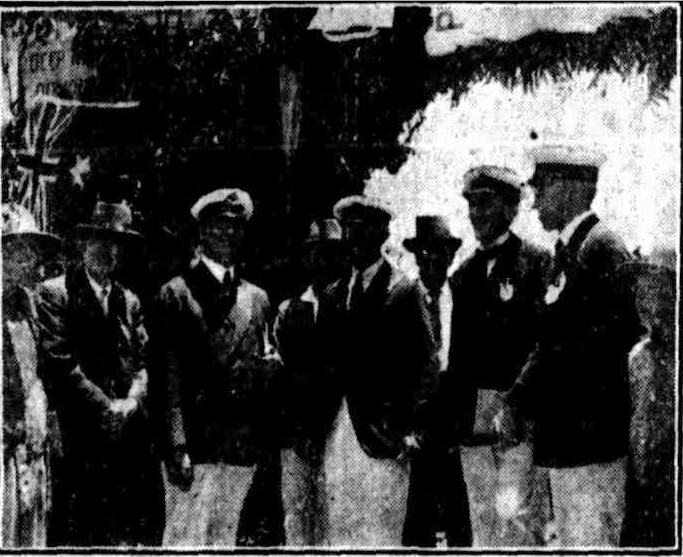
The Navy League was established in Australia in November 1900 as the Australian branch of the United Kingdom Navy League. By 1950 they operated independently of their British parent. Their aim is as an advocacy group dedicated to creating interest in maritime and naval matters, particularly those relating to the Royal Australian Navy (RAN) and the Australian Merchant Navy. In 1920, the New South Wales branch of the Navy League established a cadet-training organisation, the Navy League Sea Cadet Corps.
SEA CADETS. The Navy League's Work.
(BY EDGAR H. FIDDEN.)
The Navy League Sea Cadets were not called into being like the Scouts by an organizer with a definite aim. Units accumulated here and there under the auspices of the Navy League and the object may be significantly defined as a body of lads formed for the purpose of receiving Instruction in things nautical and physical , with moral training, as a unit recognised by the Navy League, to develop In them the principles of good citizenship. They are controlled by public-spirited but little known workers who do good in the capacity of officers , men who have a thorough understanding of boys and a gift for leadership; and the result of the training is due almost entirely due to the genius of these officers most of whom are ex-servicemen with years of sea experience to their credit. The cadets are a fine lot of boys and they get a splendid training; here is maintained the highest standard of moral, discipline and zeal. If on joining the cadet lacks the necessary finish in character, manners or habits he acquires it before he leaves.
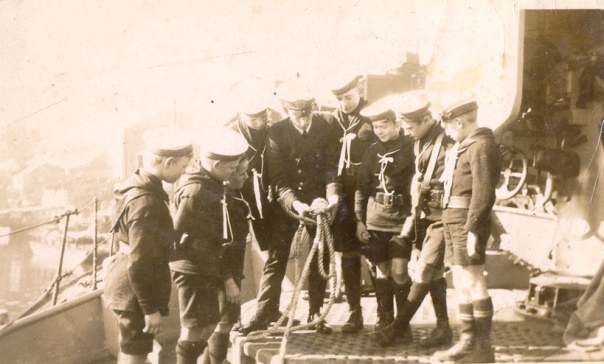 Of course the depots are not Oxfords or Cambridges; still the subjects taught, once mastered are calculated to be retained by the cadets and will undoubtedly help them 'considerably in their life’s work,no matter what vocation they may see fit to follow. The faith of these boys in the British Navy is grand: many hate gone to sea and are serving in the Australian Navy. It is believed they have not been disillusioned
Of course the depots are not Oxfords or Cambridges; still the subjects taught, once mastered are calculated to be retained by the cadets and will undoubtedly help them 'considerably in their life’s work,no matter what vocation they may see fit to follow. The faith of these boys in the British Navy is grand: many hate gone to sea and are serving in the Australian Navy. It is believed they have not been disillusioned
The elementary schools do much but they are placed at a certain disadvantage in comparison to the voluntary organisations when character training is the object for a boy goes to school because he has to but he joins the Navy League Sea Cadets because he wants to and discipline as part of a game is welcome where it would be irksome as part of a task. We have had a disarmament countence, we will continue to scrap warships; we hate war but boys the world over will still make wooden boats and will play at sailors and soldiers so long as a boy has the ardent nature of a boy and the spirit of the sea. The masculine spirit of play is a fundamental fact neglect will not diminish it, coercion wll not abolish it but it can be made the vehicle for the formation of character.
A COMPANY S HEADQUARTERS
It is heartening to visit a Navy League Sea Cadet company's headquarters-there is found an ‘espirit de corps’, a spirit of comradeship that is undoubtedly the boys best alternative to the atmosphere of the public school. The principal characteristic of such a voluntary organisation among boys is its fluid nature. Without constant attention it evaporates. These boys are only boys and are not legally tied to continue their cadetship for any stated period therefore to keep them their officers must be men of character and personality continually devising novelties, varying the training keeping up the interest.
At the latter end of 1920 Mr Alfred Milson, Hon. secretary of the Navy League, was approached by headquarters in London as to the possibilities of the formation of Navy League Sea Cadet units In New South Wales. Years prior to this Mr Harry Shelley, now Hon. treasurer of the league was responsible for the formation of a Sea Cadet corps at Drummoyne and many of the members have pleasant recollections of the good time given them by this philanthropic gentleman. Mr Milson saw no reason that such a movement should not find enthusiasm amongst our lads with the result that under his direction Mr W Hammer of Balmain, now senior officer in charge of the Northern District (N L Sea Cadets) was successful In forming the 1st Unit in Balmain with the object inculcating the spirit of the sea and if possible drafting them from this unit to HMAS Tingira or the mercantile marine. He received the co operation of the schoolmasters, clergy and civic authorities to this end. In the consequence that in a very short time he was successful in getting together some 50 boys and with the assistance of ex-naval officers proceeded to form classes in Morse and semaphore signaling, compass, helm, anchor, knot splices, bends, hitches, navigation, squad company, and physical drill and first aid. Sports such as swimming, cricket and football were of course not overlooked. The movement progressed for a few weeks and the officer in charge realising that the rapid increase in enlistments necessitated no small outlay In uniforms and equipment approached the Navy League the financial support was quickly forthcoming and uniform and equipment supplied-the 1st Company was thus formed. A 26ft naval cutter, signal mast, sporting material etc., was supplied by the Navy League and many sympathetic supporters donated flags, bugles drums etc.
RECONSTRUCTION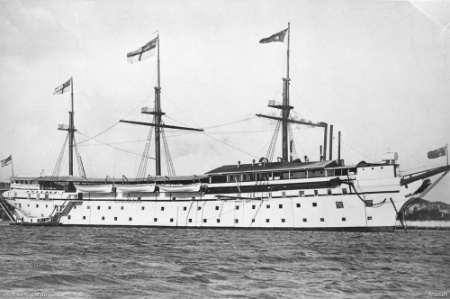 The Balmain Navy League Sea Cadet Corps, as it was then known continued to enroll the local lads and at one period had a strength of five officers and about 100 boys. Some of those cadets were quick to learn and left the corps to join H M A S Tingira, others joined the mercantile marine. The corps continued its activities until April 1922 when it was decided in view of the resignation of Mr Hammer and the necessity to vacate the waterside depot at Snails Bay, to reconstruct the company.
The Balmain Navy League Sea Cadet Corps, as it was then known continued to enroll the local lads and at one period had a strength of five officers and about 100 boys. Some of those cadets were quick to learn and left the corps to join H M A S Tingira, others joined the mercantile marine. The corps continued its activities until April 1922 when it was decided in view of the resignation of Mr Hammer and the necessity to vacate the waterside depot at Snails Bay, to reconstruct the company.
The scheme of reconstruction was undertaken by Captain W W Beale OBE(organiser of the Navy League) and Mr Edgar H Fidden (Hon secretary 1st Company) A school hall was secured at a nominal rental and In the meantime endeavours were made to Induce the State Government (through the Sydney Harbour Trust) to permit the corps to use a portion of Goat Island as a depot; unfortunately this priveleg was refused. Attention was then directed to the possibility of leasing a suitable waterside residence as classrooms for boys and ground for drill. Overtures were made to the local council for teo closing of the end of Grove- street Balmain but the civic fathers received the proposal very coldly and at the same time inferred that they were not in sympathy with the movement.
In November 1924 the corps was successful in securing a lease of a splendid property in Balmain, directly opposite Cockatoo Island and it is from here that the activities of the 1st Company of Navy League Sea Cadets are carried out. Since the formation of this company in 1920 and its reformation in 1922, other companies have been formed and with the financial support that the movement warrants forthcoming the Sea Cadets should continue to grow and provide the Navy and mercantile marine with desirable recruits who give promise of making splendid officers. SEA CADETS. (1926, October 26). The Sydney Morning Herald(NSW : 1842 - 1954), p. 10. Retrieved May 14, 2013, from http://nla.gov.au/nla.news-article16328221
The example of 'The Silent Navy’ of song and story is followed by the Navy League in Sydney. Most people are un acquainted with it. If questioned they would say that they had heard of a Navy League m England, but nothing or any organisation of the kind in Sydney. Nevertheless there is evidence of unceasing work by the league and of achievements of value. It has its own journal and through it seeks to foster the spirit of the saltwater as applied to defence. It has outward and visible signs of its activities in the form of 10 depots of sea cadets These youngsters, attend in the garb of the navy and dragging their guns, are occasionally met with on the harbour front or in boats on the harbour. The observer thinks that they are merely a show for a day called into being by some carnival. The fact is that they have existed for years. The late A G Milson was the inspiring force. He had with him a little group of men who saw eye to eye, and the 10 depots of sea cadets are results of their quiet labours. Not many years will pass before there are permanent sea cadet corps quarters on various harbour and Parramatta River points. SYDNEY DAY BY DAY. (1928, May 16). The Argus (Melbourne, Vic. : 1848 - 1957), p. 21. Retrieved from http://nla.gov.au/nla.news-article3928655
As the popularity of what was clearly a good training for boys, as well as providing both poor and rich with access to skills and knowledge, a formailised training facility. In 1951 the Navy League of Australia listed the following Sea Cadet Training Ships in its Presidential report :
New South Wales: T.S. Australia at Lavender Bay ; T.S. Warrego at Woolwich ; T.S. Perth at Manly; T.S. Sirius at George River; T.S. Beatty at Woollongong. T.S. Sydney at Snapper Island, Sydney Harbour affiliated to the New South Wales Division. Victoria: Six units: T.S. Melbourne at Port Melbourne; T.S. Cerberusat Black Rock; T.S. Anzac at Footscray Technical School; T.S. Lightning at Geelong; T.S. Henty at Portland; T.S. Avalon at Geelong Grammar School. Tasmania: T.S. Hobart of Hobart and Burnie.
The Training Ship 'Sydney' started out as the Navy League of NSW's Drummoyne Company (formed in 1922), the third unit to be formed in Australia, which in the late 1920s adopted the name for its training depot, 'Sydney', as a memorial to the original HMAS Sydney.
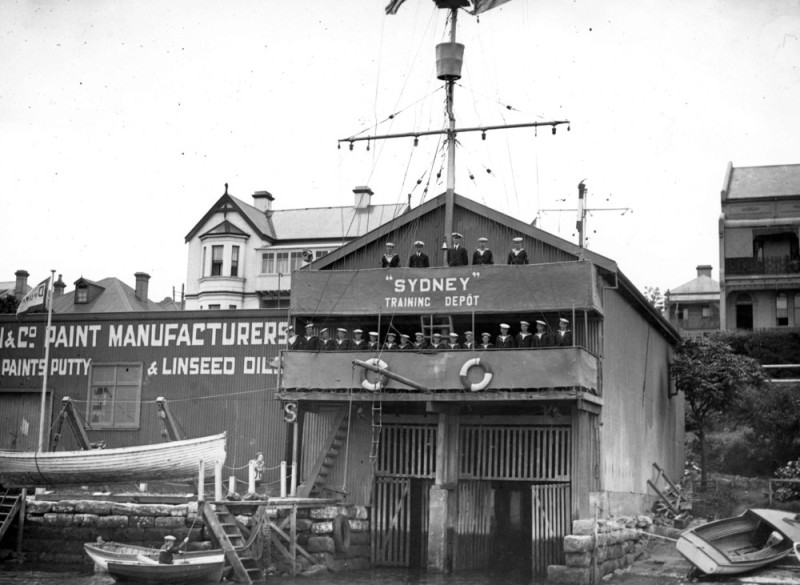
The original TS Sydney Navy League Sea Cadets depot on the waterfront of Drummoyne in the year April 1928. Picture by Sam Hood, Argus Newspaper Collection of Photographs, State Library of Victoria, Picture No: H98.105/2237.
HMAS Sydney was a Chatham class light cruiser of the Royal Australian Navy (RAN). Laid down in 1911 and launched in 1912, the cruiser was commissioned into the RAN in 1913. During the early stages of World War I, Sydney was involved in supporting the Australian Naval and Military Expeditionary Force, and escorting the first ANZAC convoy. On 9 November 1914, the cruiser defeated the German cruiser SMS Emden at the Battle of Cocos. During 1915 and 1916, Sydney operated on the North America and West Indies Station, before joining the 2nd Light Cruiser Squadron at Greenock, Scotland in November 1916. On 4 May 1917, the cruiser was involved in an inconclusive action against the German zeppelin L43; neither was damaged. During late 1917, Sydney became the first Australian warship to launch an aircraft, and the first warship to do so from a rotatable platform.
After the war's end, Sydney spent a year in reserve before being reactivated to serve as Flagship of the RAN. The cruiser was decommissioned in 1928 and broken up for scrap. Several sections of the ship, including her bow and foremast, have been preserved as monuments, and three of the ship's main guns saw later use in shore fortifications. HMAS Sydney (1912). (2013, May 3). In Wikipedia, The Free Encyclopedia. Retrieved from http://en.wikipedia.org/w/index.php?title=HMAS_Sydney_(1912)&oldid=553328731
TS Sydney is now based on Spectacle Island in Sydney Harbour. In 1931 however, the TS Sydney was moved to Snapper Island, adjacent to the Sydney suburb of Drummoyne. When nearby Cockatoo Island was passed to the Royal Australian Navy in 1913, Snapper Island was included in its 'naval waters', and as such subject to naval control. In 1930, Len Forsythe, a founder of the Navy League in NSW, leased the island from the Commonwealth Government in order to create a training depot for boys in nautical skills.
"This unit (Drummonye)of the Navy League Sea Cadets transferred in 1931 to Snapper Island, a cruiser-sized outcrop of rock in the harbour. In the 20 years which have elapsed the cadets, with the inspiration and assistance of Sea Cadet Commander Forsythe, built the finest Sea Cadet Headquarters in the British Commonwealth. The depot houses many relics of H.M.A.S. Sydney, Tread Plate, Telemotor, Telegraphs, and even Topmast. There are relics of other ships ranging from the bath tub from H.M.A.S. Anzac 1, to the survey cutter Silvio, once carried by H.M.A.S. Moresby (ex-H.M.S. Silvio). "Almost 3,000 Sea Cadets have been trained here through the years, and it is only within the last 12 months that any assistance has been given by the Navy. (This assistance is still limited to the issue of uniforms and a limited quantity of instructional equipment.) The depot now comprises the T.S. Sydney, unit of the Australian Sea Cadet Corps and also the headquarters of' the New South Wales division of the Corps. Also established here is a unit of the G.N.T.C."
Sub-Lieutenant John H. O'Connell, October 1949, The Navy magazine.
Young Tars Who Train Themselves
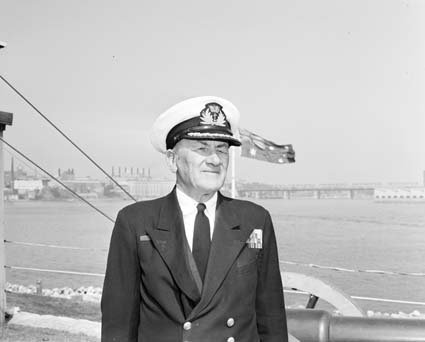 Ten years ago, as far as Sydney is concerned, there was no real organisation for training lads for a sea career in the navy or mercantile marine. Leonard E. Forsythe (pictured left, circa 1960), today Commander of a voluntary sea training establishment in the Sydney Harbor, commemorated the H.M.A.S. Sydney by establishing a depot to train Australian lads for the sea.
Ten years ago, as far as Sydney is concerned, there was no real organisation for training lads for a sea career in the navy or mercantile marine. Leonard E. Forsythe (pictured left, circa 1960), today Commander of a voluntary sea training establishment in the Sydney Harbor, commemorated the H.M.A.S. Sydney by establishing a depot to train Australian lads for the sea.
In 1928 Snapper Island was a scrub-covered, unoccupied, unwanted pinnacle of rock in Sydney Harbor. At Drummoyne, on the land side of the island, a small company of Navy League Sea Cadets was established. They were 15 strong, with half a boat shed for their home, and three ancient boats only. In six weeks these few boys, raised £54 — in pennies — money sorely needed to buy gear and repair their boats. In 1929, the 'Sydney' Training Depot was born at Iron Cove, Drummoyne. The little company of 15 had swollen to between 60 and 70, and their commander training a vigorous course of training. In 1929 the Commonwealth Government granted a lease of the pinnacle rock, called Snapper Island. The work was tackled without funds on July 7, 1931. The scrub was cleared away, and a practical survey was made of the actual surface of the island. In order to secure a flat surface for constructional purposes, the island had to have nearly 10 feet cut off it, an operation requiring the removal of 1,000 tons of rock by blasting. Not only did the company tackle this problem, but the spoil was used to build a wall 279 feet long. 8 feet high, and 5 feet thick. On completion the area of the island had been increased by one-third. All this was done in under six months, and without subsidy. The rough work accomplished, a wharf, guard room and concrete re taining wall on the reef, were built, and again on the western side 69 feet by 100 feet was reclaimed. Next came the erection of a signal station and the main buildings 100 feet by 50 feet, planned on the lines of a ship. All cabins and departments lead off a main deck, and the forward end contains quarters for the commander, also an office. Today, the island is always manned, and with the authority of the Commonwealth Weather Bureau, weather signals for some years were displayed for the benefit of all. The look-out
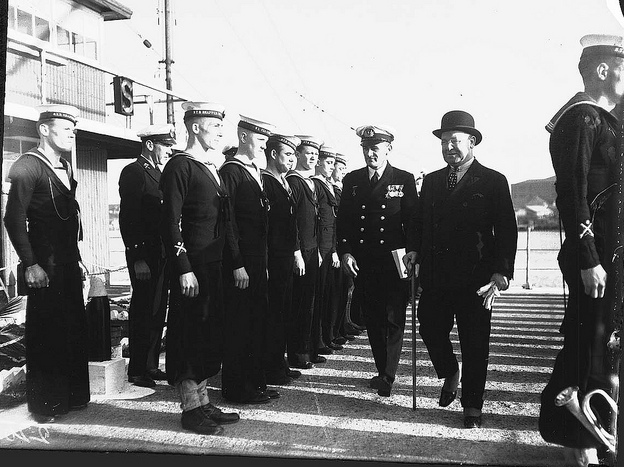 Sir Robert Archdale Parkhill inspects Navy Sea League Cadets at Snapper Island, Sydney. This photograph depicts Federal Minister for Defence Sir Robert Archdale Parkhill (in a bowler hat), inspecting the Navy Sea League Cadets at Snapper Island in Sydney on 20 July 1935. Minister Parkhill presented badges to the cadets for their part in building the depot as a national memorial to HMAS SYDNEY I, which had been decommissioned in 1928 and scrapped in 1932. This photo is part of the Australian National Maritime Museum’s Samuel J. Hood Studio collection. Sam Hood (1872-1953) was a Sydney photographer with a passion for ships. His 60-year career spanned the romantic age of sail and two world wars. Image No: Object no. 00024972
Sir Robert Archdale Parkhill inspects Navy Sea League Cadets at Snapper Island, Sydney. This photograph depicts Federal Minister for Defence Sir Robert Archdale Parkhill (in a bowler hat), inspecting the Navy Sea League Cadets at Snapper Island in Sydney on 20 July 1935. Minister Parkhill presented badges to the cadets for their part in building the depot as a national memorial to HMAS SYDNEY I, which had been decommissioned in 1928 and scrapped in 1932. This photo is part of the Australian National Maritime Museum’s Samuel J. Hood Studio collection. Sam Hood (1872-1953) was a Sydney photographer with a passion for ships. His 60-year career spanned the romantic age of sail and two world wars. Image No: Object no. 00024972
Like A Ship
The main depot is built on the lines of a ship. It is 100 feet by 60 feet, and all cabins and departments lead off a main deck, which is 60 feet by 25 feet. At the bow end are quarters for the commander and an office. On this main deck is the most complete collection of relics of the original H.M.A.S. Sydney. There is a spotless little hospital in one cabin, equipped as a service unit with full medical sup plies. Another cabin is the officer's ward room, while adjoining is the distributing office, and a regulation gunnery with racks in which are service rifles. The musical equipment of drums and bugles are there, too. In addition there is a general store, chief petty officer's mess, and the seamen's 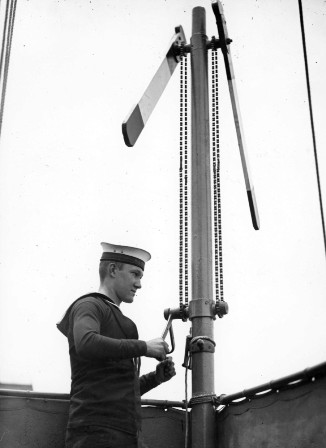 cabin, which leads off from a well equipped galley. Even the crockery bears the company's name. The canteen leading off the main deck supplies suitable light refreshments and budgets to show a profit of 5, a week. The seamen's mess will seat 50. The engine room, aft of the main deck houses a powerful petrol motor which provides power and light for the whole establishment. Right forward facing Drummoyne is the perfectly designed, two-storied signal station. The lower storey contains the quartermaster's lobby and a spot less sick bay. On the upper deck is the navigating station lines with pigeonholes which- are filled with in numerable flags.
cabin, which leads off from a well equipped galley. Even the crockery bears the company's name. The canteen leading off the main deck supplies suitable light refreshments and budgets to show a profit of 5, a week. The seamen's mess will seat 50. The engine room, aft of the main deck houses a powerful petrol motor which provides power and light for the whole establishment. Right forward facing Drummoyne is the perfectly designed, two-storied signal station. The lower storey contains the quartermaster's lobby and a spot less sick bay. On the upper deck is the navigating station lines with pigeonholes which- are filled with in numerable flags.
Wireless And Signalling
A very interesting unit on this top deck is short wave station VK2FB There are a number of instructional sets and the boys are all taught to transmit and receive messages and to construct sets. On the bridge is a regulation semaphore signalling unit and several lads are always at work, receiving messages from the complements that are out c-n the harbor on boat drill. The mast, which towers above the signalling station, is proof positive of competent workmanship. Perfectly rigged by two of the boys, it is 84 feet high, and as part of his training, every lad must be at ease up aloft. There are regulation boat rooms at the lancing, and it must be second nature to these boys to get about the booms, and I down into the boats in no time. Every new recruit is taught to swim in a netted enclosure. After a reasonable time he must be 'au fait' with practical seamanship in every branch. For this work there are 16 boats, and much work is needed to keep them in repair. The fleet, all told, has four whalers, many gigs, a cutter, and three motor boats. The island is never left unguarded. Apart from week-end and mid-week training some members of the company are always on board and keep regular watches. Every inch of the island is occupied. There are paint rooms, engine rooms for repairs, all made by enthusiastic young Tack tars and, of course, slips and boat sheds, to say nothing of a 'clink’, which is seldom, if ever, needed. The next problem to be faced is further reclamation to enlarge the island again. Young Tars Who Train Themselves. (1937, December 30). Chronicle (Adelaide, SA : 1895 - 1954), p. 45. Retrieved from http://nla.gov.au/nla.news-article92477837
Although Sea Cadets clearly frequented Pittwater Regattas and trained here it was the Manly branch of Sea Cadets that were our Northern Beaches representatives:
NAVY LEAGUE CADETS' MARCH. With Empire and company flags fluttering bravely in the breeze, about 250 Navy League sea cadets marched through the city streets on Saturday morning. The vigorous music of the Birchgrove Company band, which led the march, brought people running up side streets to see what was afoot, and filled office windows with heads. The march was the one held every year in connection with the Navy League ball (taking place this year on Monday night at the Wentworth). Mr. R. M. Sommerville had charge of the demonstration. At the heels of the standard-bearers and of the band, with its smart drum-major, came detachments from North Sydney, Mosman, Lane Cove, Manly, Birchgrove, Balmain, Drummoyne, and eastern suburbs. There was also a large lorry, with a banner. The route lay from West Circular Quay, via Pitt and Market Streets, St. James-road, Macquarie and Bridge streets, Macquarie-place, and Loftus-street, to Customs House-square. NAVY LEAGUE CADETS' MARCH. (1928, June 4). The Sydney Morning Herald (NSW : 1842 - 1954), p. 4. Retrieved from http://nla.gov.au/nla.news-article16469586
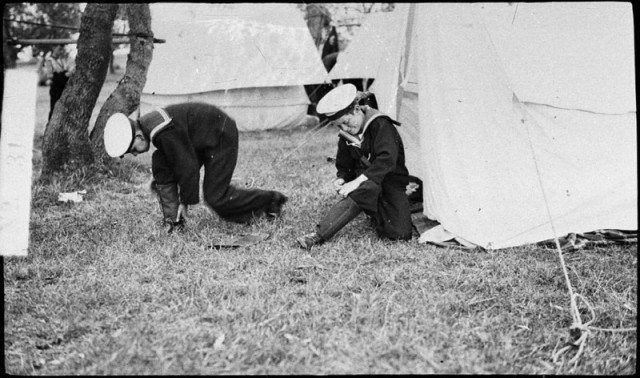 Right: Cadets at Navy League camp dressing in sailor uniforms, Long Reef (Collaroy), 1927. Photo by A J Perier, Home and Away - 34241, courtesy State Library of NSW.
Right: Cadets at Navy League camp dressing in sailor uniforms, Long Reef (Collaroy), 1927. Photo by A J Perier, Home and Away - 34241, courtesy State Library of NSW.
NAVY LEAGUE BALL.
The Dungovan, Manly, was gaily decorated with flags and bunting last night when the Manly branch of the Navy League of Sea Cadets held its annual ball. A guard of honour was formed by the Manly sea cadets for Commander Leo Quick, who represented Rear-Admiral Evans. He was accompanied by Mrs. Quick, who received a posy from the sea cadets. Others in the official party were Mr Forster Newlands, representing Navy League headquarters, and Mrs Newlands Mr and Mrs V J Brady (Mayor and Mayoress of Manly), Lieut Brown, R A N, Lieut McCardell, R A N , and Mr H Lane, chairman of the Manly branch of the league. Many of the guests were in uniform, as the dance was an official one. NAVY LEAGUE BALL. (1929, August 2). The Sydney Morning Herald (NSW : 1842 - 1954), p. 4. Retrieved from http://nla.gov.au/nla.news-article16572287
All the training led to various displays and competitions between the branches to test out their new skills:
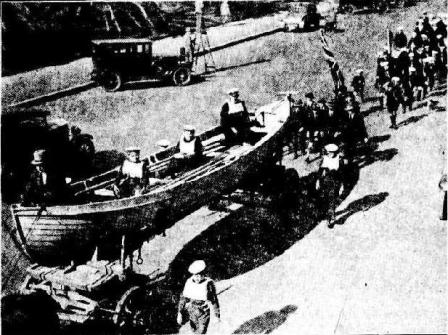 Left: NAVY LEAGUE SEA CADETS. THE NAVY LEAGUE SEA CADETS MARCHED THROUGH THE CITY ON SATURDAY. HEADED BY THE BAND FROM H.M.A.S. SYDNEY. NAVY LEAGUE SEA CADETS. (1926, July 26). The Sydney Morning Herald (NSW : 1842 - 1954), p. 14. Retrieved from http://nla.gov.au/nla.news-article16308407
Left: NAVY LEAGUE SEA CADETS. THE NAVY LEAGUE SEA CADETS MARCHED THROUGH THE CITY ON SATURDAY. HEADED BY THE BAND FROM H.M.A.S. SYDNEY. NAVY LEAGUE SEA CADETS. (1926, July 26). The Sydney Morning Herald (NSW : 1842 - 1954), p. 14. Retrieved from http://nla.gov.au/nla.news-article16308407
NAVY LEAGUE SEA CADETS. On Saturday afternoon the Navy League Sea Cadets will hold their annual competition for the Charles-Fairfax flag. Led by Birchgrove cadets' band, squads from Mosman., North Sydney, Middle Harbour, Eastern Suburbs, Lane Cove, Balmain, Birchgrove, and Drummoyne will march from the Conservatorium to the Inner Domain, where the competitions will commence at 2.45 p.m. NAVY LEAGUE SEA CADETS. (1928, March 16). The Sydney Morning Herald (NSW : 1842 - 1954), p. 13. Retrieved from http://nla.gov.au/nla.news-article16449647
NAVY LEAGUE RACE, OSWALD MCMASTER CUP.
The annual race for the Oswald McMaster Cup will take place this afternoon on the Parramatta River, over a course between Gladesville Bridge and Fivedock Bay. The cup will this year be competed for by crews of sea cadets from Mosman, Lane Cove, Birch- grove, North Sydney, Manly, Eastern Suburbs, Balmain, and Drummoyne. Service boats will be used, and the race will commence at 3 30 pm. ROWING. (1928, April 28). The Sydney Morning Herald (NSW : 1842 - 1954), p. 22. Retrieved from http://nla.gov.au/nla.news-article16460479
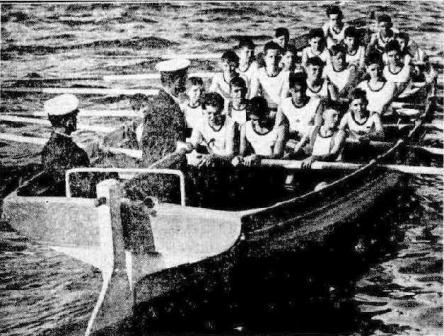 Right: NAVY LEAGUE SEA CADETS. CLOVELLY CREW, WINNERS OF THE HALF-MILE RACE. NAVY LEAGUE SEA CADETS. (1927, August 29). The Sydney Morning Herald (NSW : 1842 - 1954), p. 14. Retrieved from http://nla.gov.au/nla.news-article16400131
Right: NAVY LEAGUE SEA CADETS. CLOVELLY CREW, WINNERS OF THE HALF-MILE RACE. NAVY LEAGUE SEA CADETS. (1927, August 29). The Sydney Morning Herald (NSW : 1842 - 1954), p. 14. Retrieved from http://nla.gov.au/nla.news-article16400131
NAVY LEAGUE SEA CADETS. The race for the Cochrane Shield for Navy League sea cadets was held on the Lane Cove River. Ten boats started, and a very closely-contested race resulted. Birchgrove Cutter, 1; Drummoyne Gig, 2; North Sydney Gig, 3; Leichhardt Gig, 4. Fifty yards covered the ten boats at the finish. NAVY LEAGUE SEA CADETS. (1929, December 3). The Sydney Morning Herald (NSW : 1842 - 1954), p. 18. Retrieved May 14, 2013, from http://nla.gov.au/nla.news-article16606673
Our Australian Navy Cadets formed from the Australian Naval Reserve Cadet Corps and the Navy League Sea Cadet Corps.
Navy Aid In Training Of Sea Cadets
By A STAFF CORRESPONDENT
THE recent decision of the Department of the Navy to recognise officially and help to train Sea Cadets, sponsored by the NavyLeague of Australia, is expected to stimulate the flow of young recruits into the Navy. The Sea Cadet movement is now controlled by a council formed by the Navy League and Department of the Navy. Chairman of the council is the Director of Naval Reserves, whose senior staff officer is also a member. Sea Cadet headquarters for the N.S.W. diyision are at Schnapper Island-a harbour rock platform which adjoins Cockatoo Island.
The Sydney training depot was founded in 1928 with the idea of perpetuating naval honours won by Australia in the first World War, and as a permanent memorial to the first H.M.Ä.S. Sydney. Many souvenirs from the first Sydney, which sank the German raider Emden in 1914, are on Schnapper Island. In the last 20 years more than2,300 boys have received training from the Sea Cadet Corps at Schnapper Island. Many of them are serving on ships of the Royal Australian Navy and with the Mercantile Marine.
Volunteers for the Sea Cadets are accepted at 14 years. Occasionally boys as young as 10 are enrolled. They are outstanding types who arc preselected for training that will fit them to enter Flinders Naval College as midshipmen. In six years training at Schnapper Island the boys receive promotion to cadet leading seaman and cadet petty officer. Courses include signalling, physical training, navigation, power-boat maintenance and management, rifle drill, and boat work under sail and oars. In Sydney there are Sea Cadet units at Schnapper Island, Lavender Bay, Woolwich, Manly, and George's River. Wollongong has an active branch, and a new unit is being formed at Newcastle. Navy Aid In Training Of Sea Cadets. (1951, October 29). The Sydney Morning Herald (NSW : 1842 - 1954), p. 2. Retrieved from http://nla.gov.au/nla.news-article18236991
After 1973, Our Royal Australian Navy assumed full responsibility for the Corps, which was renamed the Naval Reserve Cadets. The Australian Government review, 'Cadets The Future' recommended a final name change to Australian Navy Cadets in 2000. ANC training continues to be nautical in nature. Current activities can include, but are not limited to, navigation, communications, first aid, drill, maritime history, firearms proficiency and adventurous training. The ANC also still aims to achieve the following with its training program:
develop an interest in the Navy and its tradition; encourage cadets to continue military or some form of community service; give cadets a foundation of military knowledge and discipline; develop the qualities of leadership, self-discipline, self-reliance and initiative; and
provide training that may later assist in achieving competencies required during Navy induction training.
The Navy League still exists in Australia. Their Patron-in-Chief is Her Excellency Ms Quentin Bryce AC, Governor-General of the Commonwealth of Australia.
On June 15th 2013 the Avalon Tattoo will feature all of our Services cadets with our Navy Cadets having the honour this year, as the Tattoo is set up so all services take a turn each year, of presenting the traditional Challenge.
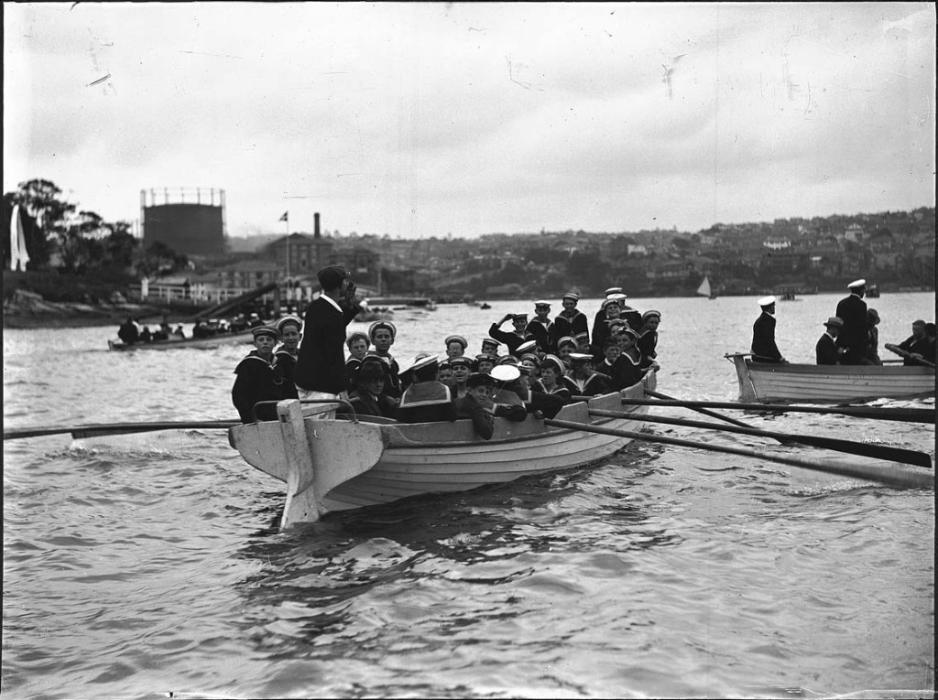
Australian Sea Cadets in open boats by Sam Hood. This glass plate negative depicts a large group of uniformed Australian Sea Cadets (also formally known as Naval Reserve Cadets and now known as the Australian Navy Cadets) in an open boat near the Squadron's headquarters in Kirribilli. In the background to the left, a whale's jawbones are visible and form an archway to the Squadron's main building. The jawbones originally came from a whaling station at Twofold Bay, on the south coast of New South Wales. A caption on the negative reads: 'Opening yacht season'. From and Courtesy of ANMM Collection, Image No.: 00024222.
YACHTING. Royal Sydney Yacht Squadron. SEASON TO OPEN ON SATURDAY. The Royal Sydney Yacht Squadron will hold its official opening function of the season on Saturday afternoon There will be a gathering of members and their friends In the club house and grounds the verandah being available for dancing On the water all yachts and boats not engaged In racing will anchor off the club house at 2 30 p m and at 3 pm will dress ship upon the firing of a gun and the making of the signal VXI from the squadron flagpole. During the afternoon there will be scratch races for the 21ft restricted class and 12ft cadet dinghies and handicaps for boats of the S A S C and 16ft skiffs as well as a rowing race for gigs cutters whalers and skiffs of the Navy League Sea Cadets. YACHTING. (1930, October 16). The Sydney Morning Herald (NSW : 1842 - 1954), p. 17. Retrieved from http://nla.gov.au/nla.news-article16722981

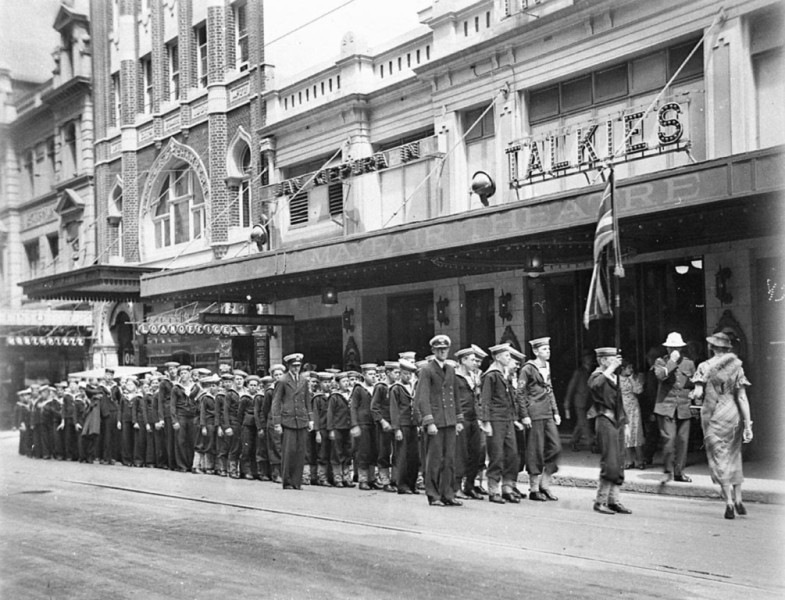
Navy League cadets marching into the Mayfair Theatre, circa 1935. Photo by Samuel Hood, Home and Away - 5967, courtesy State Library of NSW.

Some of the original P.O.s & "Men" of the Navy League Sea Cadets taken 1928. Argus Newspaper Collection of Photographs, State Library of Victoria. Image No: H98.105/2238.
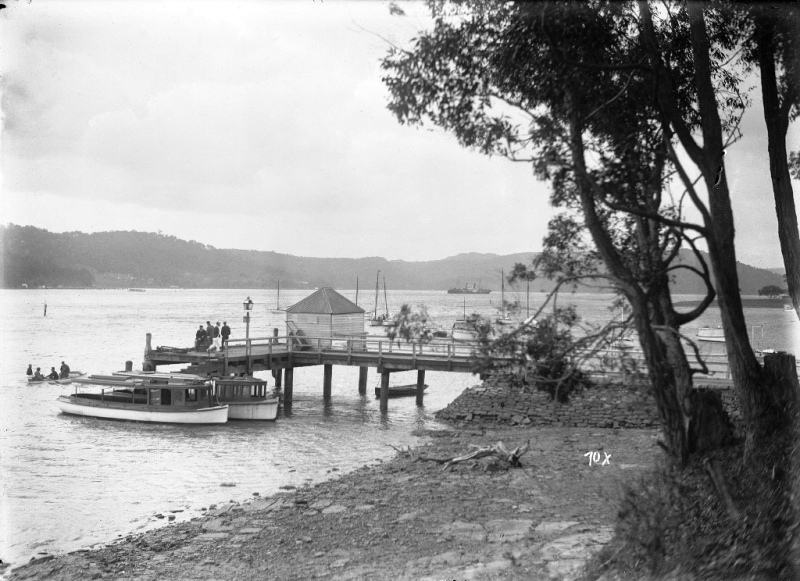
Newport Wharf at the 1928 Pittwater Regatta with SS Newcastle seen in the background. Photo by William J Hall or his father William Frederick Hall.Courtesy Austalian National Maritime Museum Flickr collection, 00012150
Navy League Sea Cadets In Pittwater threads collected by A J Guesdon, 2013.
|
|